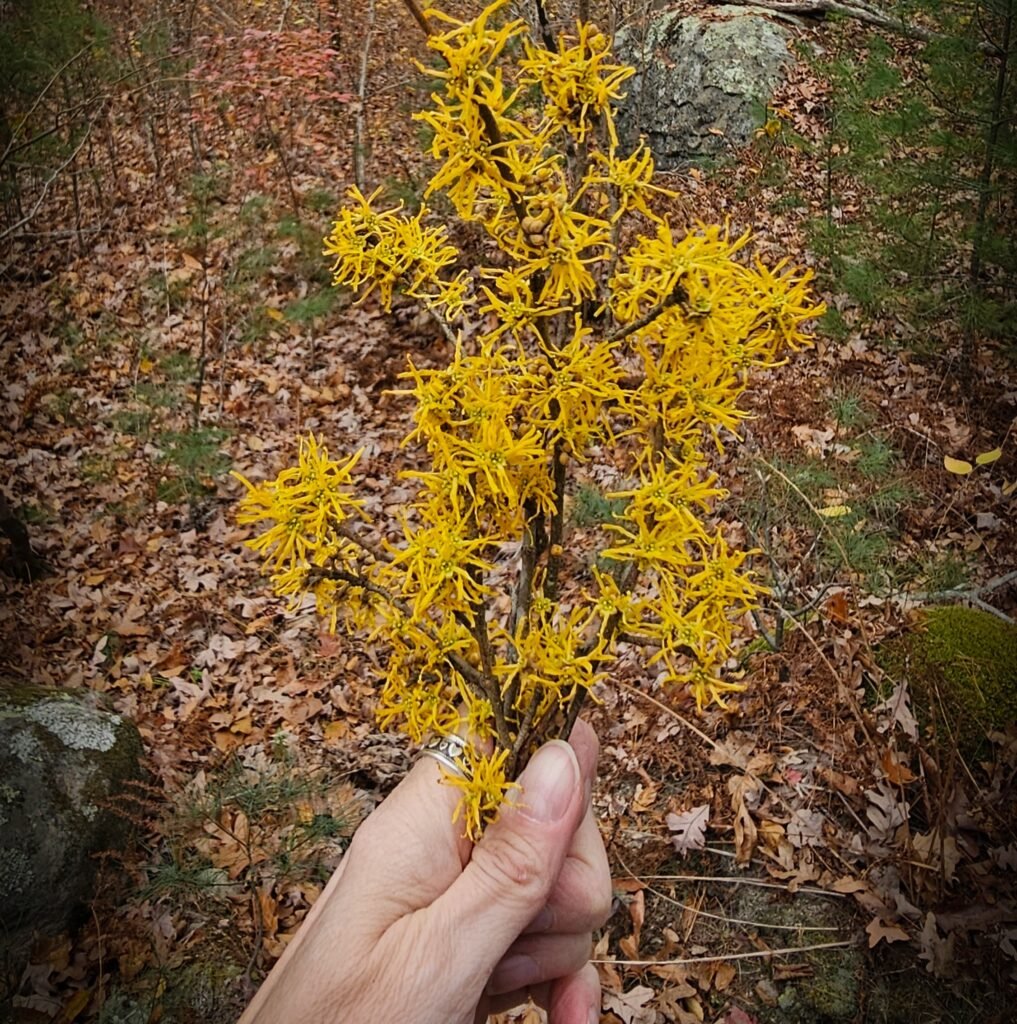The Outdoor Apothecary is reader-supported. When you buy through links on our site, we may earn an affiliate commission. Learn more
What is Witch Hazel For?
In this blog post, we will answer the question what is witch hazel for as well as other questions about this valuable herb. We will explore what this herb is, what it does, how to use it, and even how to make your own witch hazel extract.
The magical qualities of witch hazel have been known for centuries. In ancient Greece, it was used to ward off evil spirits and witches. Indigenous people used the shrub as a cure-all for all sorts of ailments including sore throat, earache, skin inflammation, and snakebites.
Today, we know that witch hazel is used to address a variety of ailments. Here are a few things that witch hazel can be used for:
- Calms Inflammation. Inflammation is a normal immune response designed to protect your body against injury and infection.
- Reduces Skin Irritation.
- Helps soothe Hemorrhoids.
- Fights Acne.
- Alleviates Scalp Sensitivity.
- Soothes Sore Throat.
- Protects Against Skin Damage.
- Wards off Infection.

WHAT IS WITCH HAZEL FOR & HOW TO IDENTIFY?
Witch hazel is a small deciduous tree growing to 15 feet in the Eastern United States and Canada. This small tree has twisting stems and long forked branches. It can be found as an understory tree or shrub, meaning it likes to grow beneath other trees.
Although witch hazel appears rather nondescript in summer, it shines in the fall, when its leaves turn yellow, and its fragrant flowers appear.
There are several different types of witch hazel, but we’ll focus on one here: Hamamelis virginiana (the common witch hazel). This is what you’ll find at your local health food store and online for personal care products like astringents and toners.
It’s important to know how to identify witch hazel so that you don’t accidentally pick up another plant! Let’s break it down by its parts:
- The leaves of the witch hazel shrub tend to be oval-shaped, coarsely toothed, and grow in an opposite pattern. The stems are hairy.
- The bright yellow flowers are threadlike and appear in usually September and October.
- The bark of witch hazel can be scaly or smooth depending on the age of the tree or shrub. Its bark may be gray or brown with lighter colored stripes running down it.
- The branches of witch hazel are best known for their unique ability to bend or break. This is because witch hazel has rather pliable twigs due to the fact that they contain high amounts of a certain type of elastic fiber.
WHERE CAN YOU FIND WITCH HAZEL?
Witch hazel likes moist conditions and can typically be found growing wild in eastern North American woodlands and along streams and riverbanks.

POSSIBLE SIDE EFFECTS
Medical professionals consider witch hazel to be safe when applied directly on the skin, but not if swallowed. This is because witch hazel contains tannins that can cause stomach problems like nausea and vomiting if consumed in large amounts.
*Folk herbalists consider drinking a tea from witch hazel or taking a tincture of witch hazel prepared with high-quality alcohol (never isopropyl) to be generally safe.
People prone to rosacea, a skin condition that causes redness and swollen bumps on their face should be cautious about using witch hazel. If you have dry or sensitive skin please check with your doctor before applying this product.
Where can I purchase Witch Hazel?
If you don’t have access to local or homegrown herbs, I highly recommend purchasing them from Mountain Rose Herbs. They are my favorite place to buy high-quality, organic dried herbs and herbal products. As a company they believe in people, plants, and planet over profit and only ever source their herbs ethically and sustainably. It is through this ethical, responsible sourcing, that they are able to offer one of the largest selections of certified organic herbs, spices, and botanicals in North America.
MORE HERBAL REMEDIES
In Conclusion
Now that we have answered the question of what is witch hazel for, how to identify it in the wild, and its medicinal uses and benefits – are there any other herbal remedies you’re interested in learning about? We would love to be your go-to resource for all things related to herbal living. Sign up today so we can send you our latest articles and resources on herbal medicines!
Grab Your FREE Foraging Guide
Here's what's Included
The Foraging Companion is a 106 page downloadable feature-
- list of 300+ plants - information on edibility & risks
- profiles of 50+ plants with guide to identification & uses
- month by month list of plant availability
- examples of wild plants, which may be used for home treatment or first aid in the wild
- glossary of medicinal terms
Disclaimer:
The Outdoor Apothecary website is intended for informational purposes only and should not be considered a substitute for professional medical advice. The information provided is not intended to diagnose, treat, cure, or prevent any disease. While we strive to provide accurate and up-to-date information, it is the reader’s responsibility to ensure proper plant identification and usage.
Please be aware that some plants are poisonous or can have serious adverse health effects. We are not health professionals, medical doctors, or nutritionists. It is essential to consult with qualified professionals for verification of nutritional information, health benefits, and any potential risks associated with edible and medicinal plants mentioned on this website.
As an Amazon Associate, I earn from qualifying purchases.


